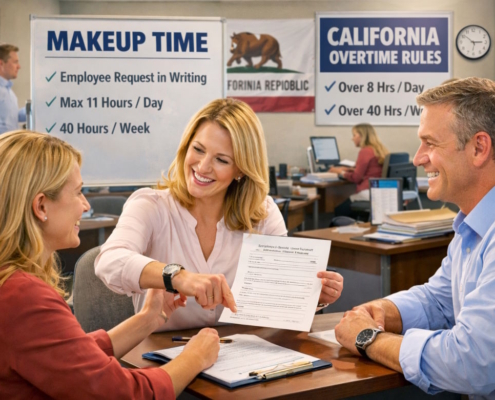Difference Between Exempt Vs Non Exempt Employees In California
In California, it is usually agreed employees have the right to (1) overtime when working over 40 hours; (2) right to be paid minimum wage; and (3) right to certain breaks including lunch/dinner. However, this usually applies to non-exempt employees. There are certain times when an employee is not entitled to these benefits and will be labeled as exempt employees.
In order to be exempt, the employee must meet certain requirements:
- Making at least twice California’s minimum wage
- Duty to use his or her own judgment in the workforce
- Employee works in administrative or executive decision making
However, even exempt employees usually are entitled to meal breaks but not rest periods.
How many breaks do you get in an 8 hour shift in California?
Generally, one ten-minute rest period is allotted for every four hours worked.
A non-exempt employee’s break depends on the length of his or her shift. For instance, if a server is working a 12-hour shift, he is entitled to three paid 10-minute rest periods and two unpaid 30-minute meal breaks. However, if you work less than three and half hours, no breaks are allotted.
What is meant by rest period?
A rest period, by definition, is an uninterrupted period of time (usually ten minutes) where an employee does not work but still is paid. An employer also must provide an area where the rest period can be taken that is not the bathrooms. An employee can voluntarily forfeit this rest period and the employer will not be held in violation of the California Code.
What happens if you don’t take breaks at work?
If one of these rest periods is not given, the employer must pay the employee one extra hour of pay.
When Must meal period be taken in California?
A meal break, in contrary to a rest period, is one that lasts 30 minutes and allows the employee to attend to his or her personal business.
An employer may not interfere with this break and must relieve the employee of all his or her job duties for the duration. It does not have to be used for eating; an employee may leave the work environment and go run errands if she so pleases. An employer does not have to provide the employee with food at this time and does not have to pay the employee for this break. Meal breaks are usually given to exempt employees unlike rest periods.
An employee is entitled to one 30-minute meal break when working over five hours and two when working over ten hours. However, an employee’s first meal break must occur before entering his or her fifth hour of work.
Further, a waiver of the first break is allowed if the employee works less than six hours. However, if the employee works longer than six hours, the meal break cannot be waived.
If the employee’s shift is sometime during 10:00pm and 6:00am, the employer must have a cafeteria or some facility that the employee can go to for a hot meal. The facility can also just have a kitchen where the employee can warm up food. Moreover, if an employee is required to take his or her meal break on-site at work, there must be an area where they can do so.
What happens if there is a violation?
If the employer does not permit an employee to take his or her allotted breaks, allows an employee to waiver his or her break when working over 10 hours, or influences an employee to give up his or her break, the employer must pay the employee. The amount depends on how many breaks have been wrongfully skipped but usually it is one hour pay for one violation.
Further, if the problem continues, it is best to speak internally with human resources first. If nothing comes from this or it is uncomfortable, speaking with a lawyer and filing a suit might be the next best decision.
Conclusion
Overall, it is very important that employers and employees recognize the law on breaks because violations can be costly. If you are not getting rest breaks or meal breaks, please contact our employment lawyer for a free consultation.






















